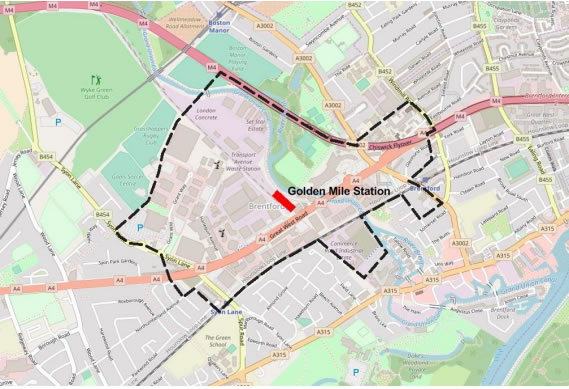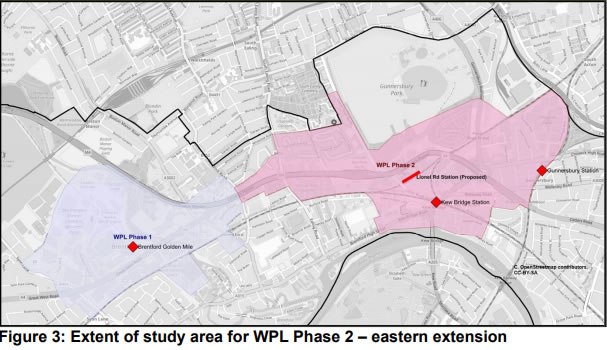Workplace Parking Levy for Brentford a Step Closer
Money raised could help fund new Brentford to Southall rail link

Proposed area of Workplace Parking Levy in Brentford
A Workplace Parking Levy (WPL) on parking spaces in the Great West Corridor area of Brentford has moved a step closer after Hounslow Council’s cabinet ratified a report recommended that the scheme be advanced.
This would mean that businesses and other organisations in the area would be required to pay an annual charge per parking space that they provide to their employees. There are approximately 4200 potentially liable parking spaces. A report by SDG consultants in 2015 concluded that the existing highway network around the Golden Mile could only accommodate the equivalent of 1,200 new jobs so the Council argue that encouraging alternative means of commuting is essential. A range of charges per annum up to £1,000 are being considered
A WPL is a charge on employers who provide workplace parking, collected and enforced by a Local Authority. All revenue generated from a WPL must be retained by the local authority and must by law be spent on transport improvements. It is paid on spaces that are regularly used by employees – spaces used by customers, visitors etc. would not pay a charge. Disabled bays for authorised blue badge holders would also be exempted. In Nottingham small employers with less than ten parking spaces are also excluded from the scheme.
A report was presented to a recent Hounslow Council cabinet meeting which included the results of a public consultation which took place in the western section of the corridor between November 2018 and January 2019 and a further update on the technical feasibility for a Brentford to Southall Rail Link which the levy is supposed to fund. The report says this line could be operational by 2024-25.
There were 42 responses to the initial consultation with a marginal majority in favour although over 30% of responses were strongly opposed. There was a clear divide between residents (and interest groups) who were broadly in favour of the scheme and local employers who were unanimously opposed.
As a result the cabinet approved a second and final public consultation on the levy which will outline the proposed design of the scheme; the tariff per space; the use of any income it raises (the spending plan) and; all the terms and conditions of its operation, including any exemptions and the enforcement arrangements. Funding sources still need to be identified for this consultation and related feasibility studies including that for the rail link which will cost £1.8m to produce.
The overall cost of the rail link was originally estimated to be £100m but the most recent report into the scheme recommended some potential changes to design to reduce cost and improve deliverability, with an outturn cost of around £80m now considered feasible. The savings have been achieved by changes such as reconsidering the location and height of the proposed Brentford Golden Mile Station and also reviewing previously proposed closures of level crossings along the route.
This will mean the plan will be brought back to the Cabinet next year to determine if an application should be made to the Mayor of London, and the Secretary of State for Transport to bring the scheme into operation.

There is also to be a further feasibility study and initial consultation on a possible second WPL scheme covering the eastern extent of the Great Western Corridor opportunity area. This could cover the eastern stretch of the Golden Mile along the A4, the area around the new Brentford FC stadium, the Power Road estate and Chiswick Business Park. The funds levied would go to the provision of a new station at Lionel Road which would be served by the proposed West London Orbital train service. The scheme could also help support transport improvements at Gunnersbury and Kew Bridge stations, alongside wider bus and cycle/pedestrian improvement schemes.
September 5, 2019